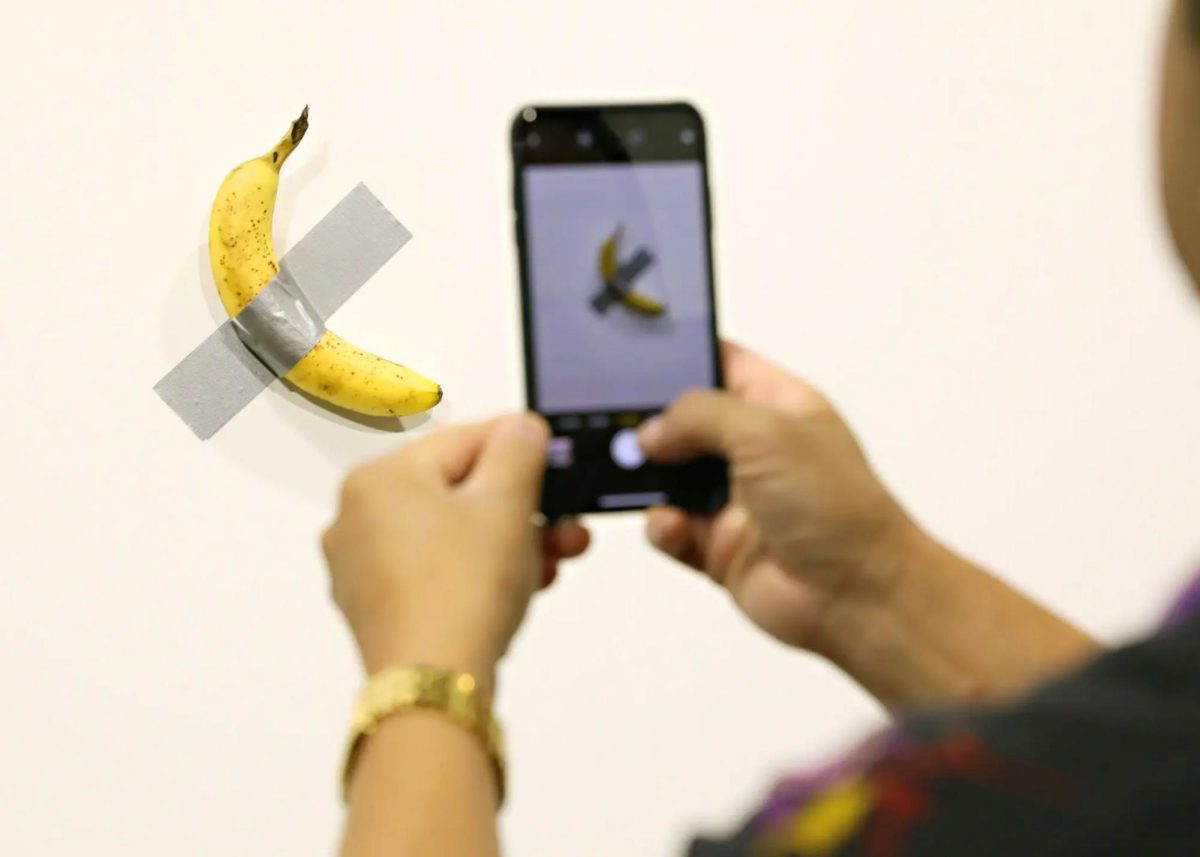As you’re scrolling through your feed, a striking headline catches your eye: “Viral banana artwork duct-taped to wall sells for $6.2M.” Obviously, the components of this installation, titled Comedian, are not worth 6.2 million dollars — grocery stores sell bananas for 20 cents each, and a roll of duct tape costs nine dollars. Is contemporary art too simple after all?
Pieces like Maurizio Cattelan’s Comedian are part of a growing trend of conceptual art, which challenges traditional notions of value and meaning by emphasizing concept over material. This shift from traditional art began in the late 19th century with the modern art movement, inspired by the growing impact of the Industrial Revolution. Society’s rapid modernization caused artists to step away from traditional idealistic imagery, choosing to focus on realism. Today, responding to new social, cultural and technological changes, new types of impressionism, abstract expressionism, minimalism and conceptual art are emerging, which some regard as “too simple” because they don’t appear to require artistic skill. Others argue, however, that despite surface level simplicity, they are valuable because they push the boundaries of art.
Institute of Contemporary Art (ICA) intern David Nguyen (III) comments, “I think it’s really cool because you get to see more [of] a feeling. […] I feel it’s more expressive [rather] than what you’d usually see in regular museums.”
Along with positive reactions such as Nguyen’s, criticism has increased tremendously. People critique paintings by artists like Agnes Martin, Donald Judd and Frank Stella — minimalists whose work is often “just a blank canvas” — for lacking depth and technical skill. Some artworks seem so basic that people consider them pointless.
Sold for 60 million dollars, Kazimir Malevich’s White on White perfectly exemplifies this sentiment. A diagonal white square painted onto a white canvas, this work claims “to create a sense of floating and transcendence,” as stated by the Museum of Modern Art. When stripped of this description, however, Malevich’s work is near-meaningless.
Boston Latin School AP Studio Art teacher Ms. Elisabeth Walshak says, “I feel conflicted about some art, like the banana duct-taped to a wall that sold for 6.2 million dollars. […] Is it just one big troll of a hyper-inflated art market that caters to extremely wealthy people in an age where wealth inequality is at its highest in human history?”
While it is be easy to dismiss contemporary artworks as pointless or meaningless, contemporary art often expresses messages that are unable to be expressed through representational art. Many artworks that are “only a solid color” like Yves Klein’s Blue Monochrome, which is displayed at the Museum of Fine Arts, challenge the nature of art itself. Walshak explains, “Yves Klein developed a new shade of blue paint using newly available pigments such that the process is interesting and these paintings challenge our preconceived notions about what painting and art should be.”
Although some viewers may find the art lacking depth, the creation process requires much more effort. According to a statement from the gallery displaying “Comedian,” “Every time [Cattelan] traveled, he brought a banana with him and hung it in his hotel room to find inspiration. He made several models: first in resin, then in bronze, [then] in painted bronze, before finally coming back to the initial idea of a real banana.”
Tyler Lum, a former youth worker at the ICA now focusing on film directing, explains the importance of the creation process: “While contemporary art may be seen as too simple or too effortless, each piece can potentially hold more stories than ordinary paintings you may see at a museum.”
What resonates with one person may not with another, and that diversity of thought is what makes the nature of art so powerful and ever-evolving. BLS Visual Arts teacher Mr. Stephen Harris encourages students interested in art to visit the Thursday Club, an after-school program on Tuesdays and Thursdays, where students can learn to use the ceramic pottery wheel, experiment with painting, drawing and more to create either modern or traditional art.
Categories:
Banana, Banana on the Wall
By Lauren Dong (III) & Sophia Knobel (III), Contributing Writers
February 9, 2025
Viewers photograph Maurizio Cattelan’s Comedian, the viral banana duct-taped to a wall. (Source: Cindy Ord)
0








